My first tarot deck was a gift from my high school English teacher. She gave me her Rider-Waite-Smith before I graduated. It was my only deck for many years. Since then, I’ve had many tarot decks and a few oracles, most of which I gave away or sold either because I didn’t connect with them or because I got rid of many belongings when I moved to Australia.
My collection has grown slowly in the last ten years that I’ve been living in Australia. There are so many tarot and oracle decks readily available now, and, on top of that, interesting independent projects appear on Etsy, Kickstarter, and personal websites. I added 16 tarot and oracle decks to my collection this year, which surprised me.
Here are my tarot and oracle decks of 2021.
Anima Mundi Tarot by Megan Wyreweden

The Anima Mundi Tarot by Megan Wyreweden is a 78-card deck with beautiful illustrations inspired by the natural world. Only one card, The Devil, shows a person. The Cups are primarily aquatic animals and coastal scenes, but the other suits are a variety of plants and animals. The associations may not be immediately apparent, but they make sense.
I have wanted an animal deck for some time, and I love the Anima Mundi tarot because it features real animals and has a calm, if moody vibe. The Anima Mundi tarot is based on the RWS, but most cards don’t depict those familiar scenes. Though it comes with a little white booklet (LWB), I recommend Anima Mundi for readers with a solid familiarity with the RWS.
The Anima Mundi Tarot was a 2017 Kickstarter, which I missed. Thankfully, this deck is available in stores. For more information, visit Megan Wyreweden’s website.
The Goddess Tarot by Kris Waldherr
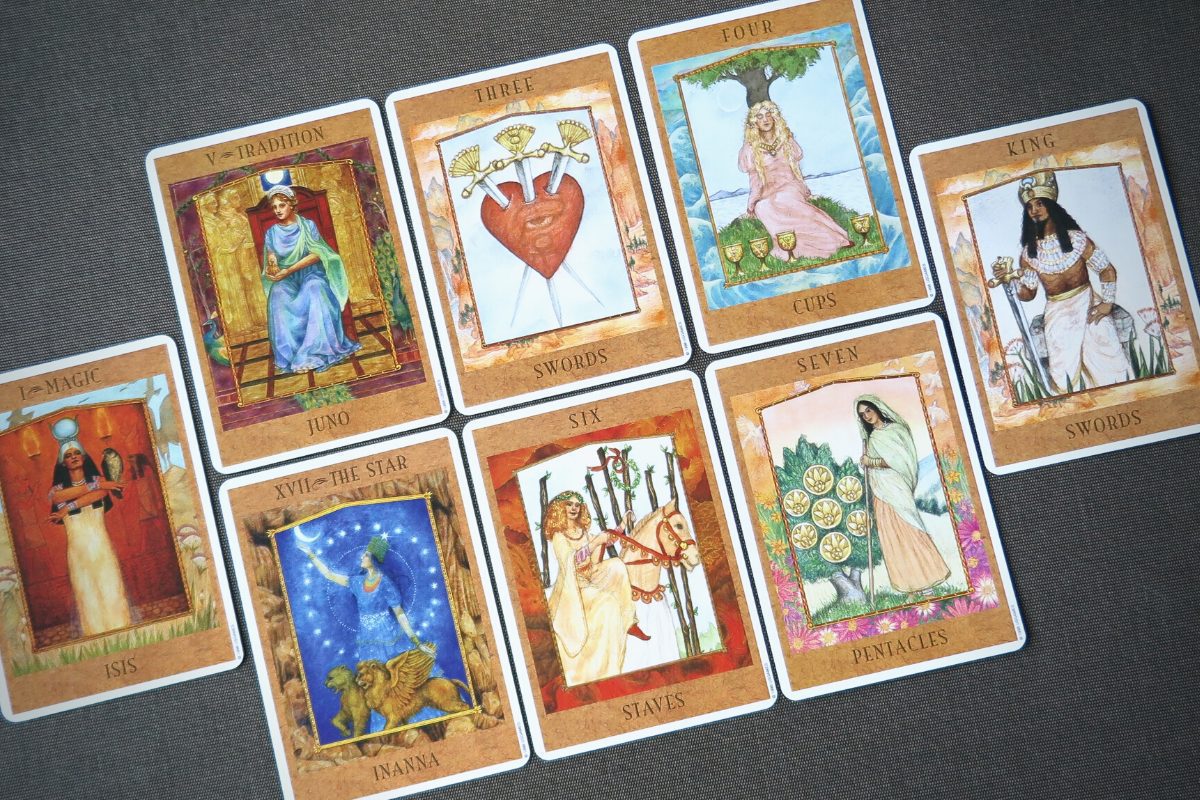
The Goddess Tarot by Kris Waldherr is one of many decks that I gave away or sold when I moved from the United States to Australia. I’m happy to have it back in my collection. According to Waldherr, the Goddess Tarot is a celebration of the Divine Feminine and applies the stories of goddesses from around the world to address women’s current needs. Only the Princes and Kings are male.
The Goddess Tarot is a soft, pretty, non-threatening deck that shows the influence of the RWS and Crowley’s Thoth, but it also does its own thing. For example, each suit is related to a goddess: cups with Venus, swords with Isis, pentacles with Lakshmi, and staves with Freyja.
I don’t think I will read with this deck much, but I like having it, and I think it will be a good deck for some female clients who might be wary of tarot.
The Golden Dawn Magical Tarot by Chic Cicero and Sandra Tabatha Cicero
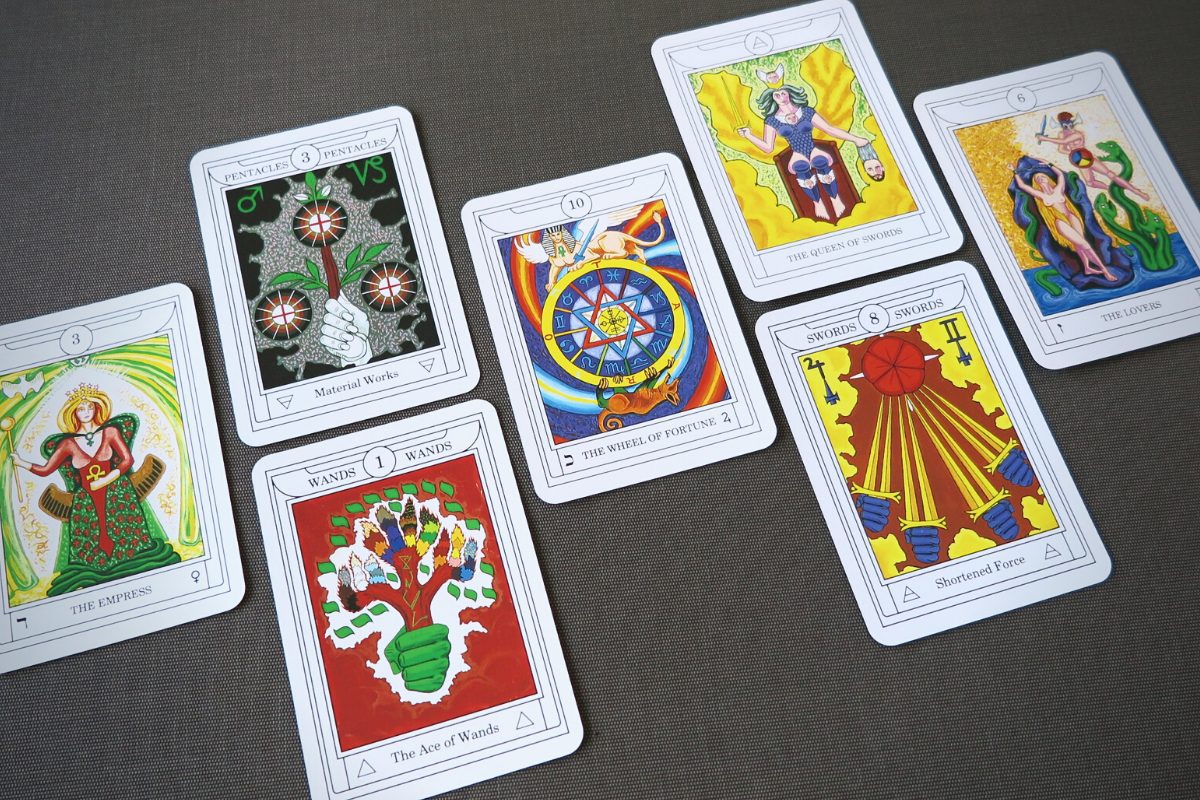
This year, I’ve been working through Donald Michael Kraig’s Modern Magick: Twelve Lessons in the High Magickal Arts. I already had one of the top three decks Kraig recommends for his lessons—the Hermetic Tarot by Godfrey Dawson, but I haven’t connected with it. So, I purchased the Golden Dawn Magical Tarot and have enjoyed that one much more. (The B.O.T.A. Tarot is the other deck Kraig recommends).
The Golden Dawn Magical Tarot is a deck intended to fulfil the traditional symbolic and ritual requirements of the Golden Dawn’s system of magick. It is for those who want to explore the relationship between tarot and Qabalah. Its LWB is a 235-page book offering a brief history of the Hermetic Order of the Golden Dawn, the fundamentals of the Qabalah, details of the cards, including astrological and elemental correspondences, and ritual and divination techniques.
The Golden Dawn Magical Tarot and guidebook are a great set for someone who wants to learn more about the tarot’s relationship to the Tree of Life.
Tarot de Carlotydes by Carlota Santos
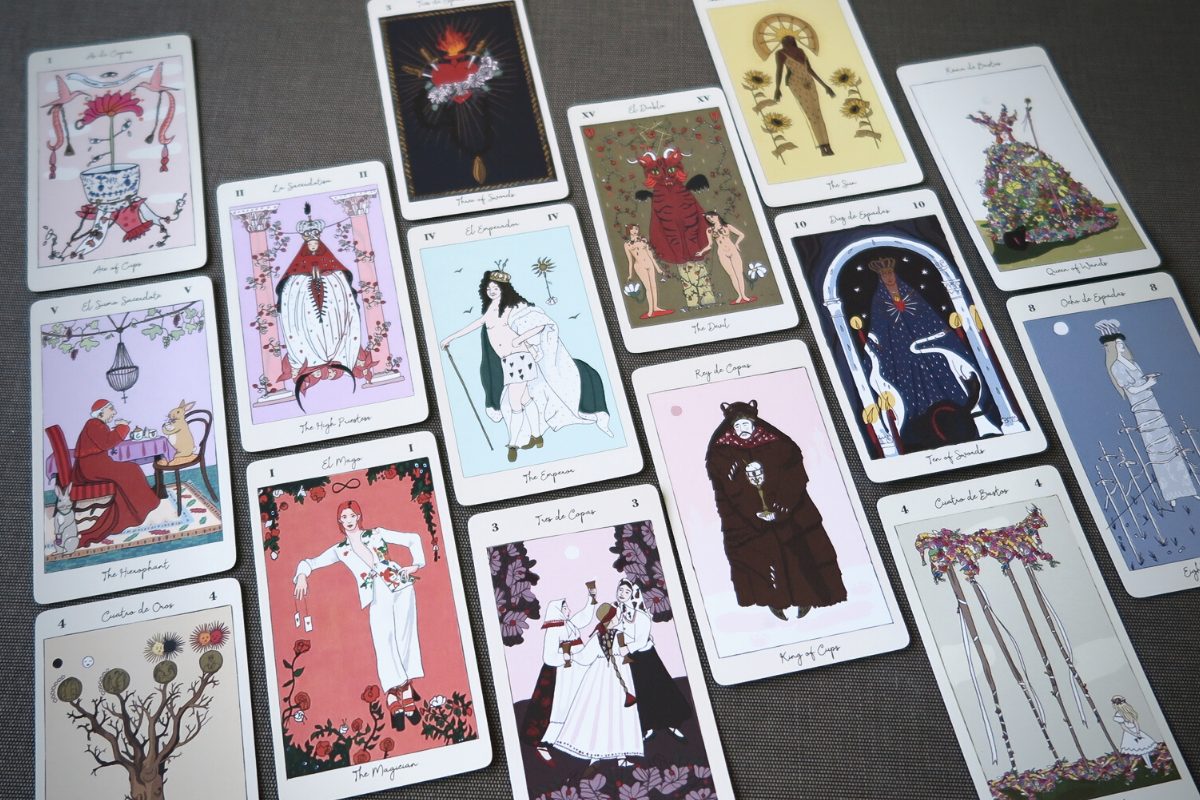
I spotted Tarot de Carlotydes on that most dangerous shopping marketplace, Etsy. It may be the most whimsical tarot deck in my collection.
The Tarot de Carlotydes blends folklore, fairy tales, historical, vintage, and contemporary imagery in a flowery, pastel colour palette. For example, the Magician was inspired by David Bowie, the Empress by Empress Elisabeth of Austria, the Emperor by Louis XIV, and the Star by Hedy Lamarr. It doesn’t entirely shy away from darker imagery–the Five of Swords shows a Hand of Glory–but in general, it’s a light and playful deck. The cards a smaller than the standard RWS.
The Tarot de Carlotydes includes a LWB with RWS meanings, but the cards depart from the familiar RWS scenes. Each suit has a colour theme: Swords are blue, Wands are green, Cups are pink, and Pentacles are yellow. I wish the LWB included a statement from the artist, Carlotta Santos, because I would love to know more about her inspiration and process.
Carlotta Santos is a Spanish illustrator, and Fournier, a well-known manufacturer of cards in Spain, edited and published the Tarot de Carlotydes. I purchased it from a retailer in Spain, but the Tarot de Carlotydes is now available from Llewellyn. To see more from the artist, visit Carlotta Santos on Instagram.
Le Tarot de Marseille-Waite by Emmanuelle Iger and Alice Laverty
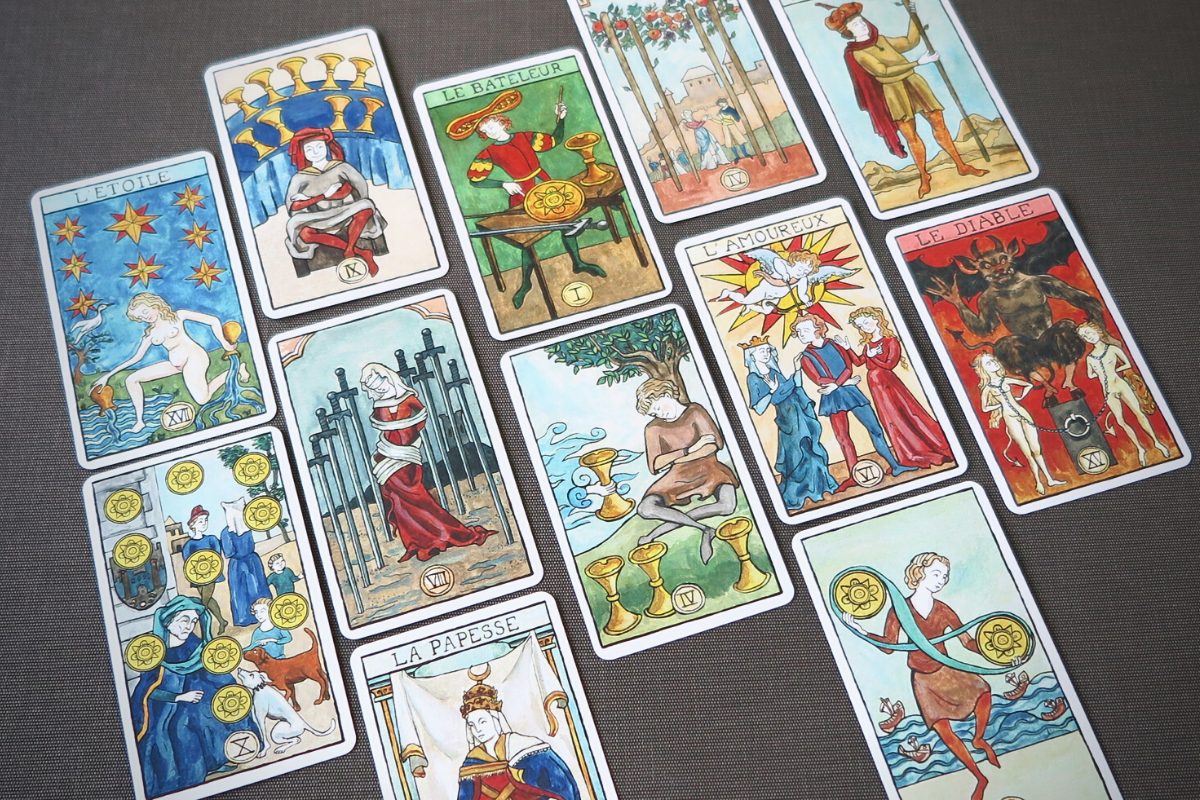
Le Tarot de Marseille-Waite is a beautiful deck that draws on the RWS and illuminations from the 12th and 13th centuries to illustrate the four suits of the Tarot de Marseilles. The Major Arcana resembles a Marseille deck, and the Minor is recognisably RWS.
I love this deck because it combines my two favourite traditions of tarot, Marseilles and RWS, and retains a historical feel. It’s comparable to the Keishobou Tarot by Gaichi Muramatsu (1973), which kept the woodcut look of the Marseille.
Le Tarot de Marseille-Waite is a French deck. The card titles and LWB are in French. For more information about Le Tarot de Marseille-Waite, visit Emmanuelle Iger’s website.
Tarot de Marseille of the New Incarnation by Eugene Vinitski and Elsa Khapatnyukovski
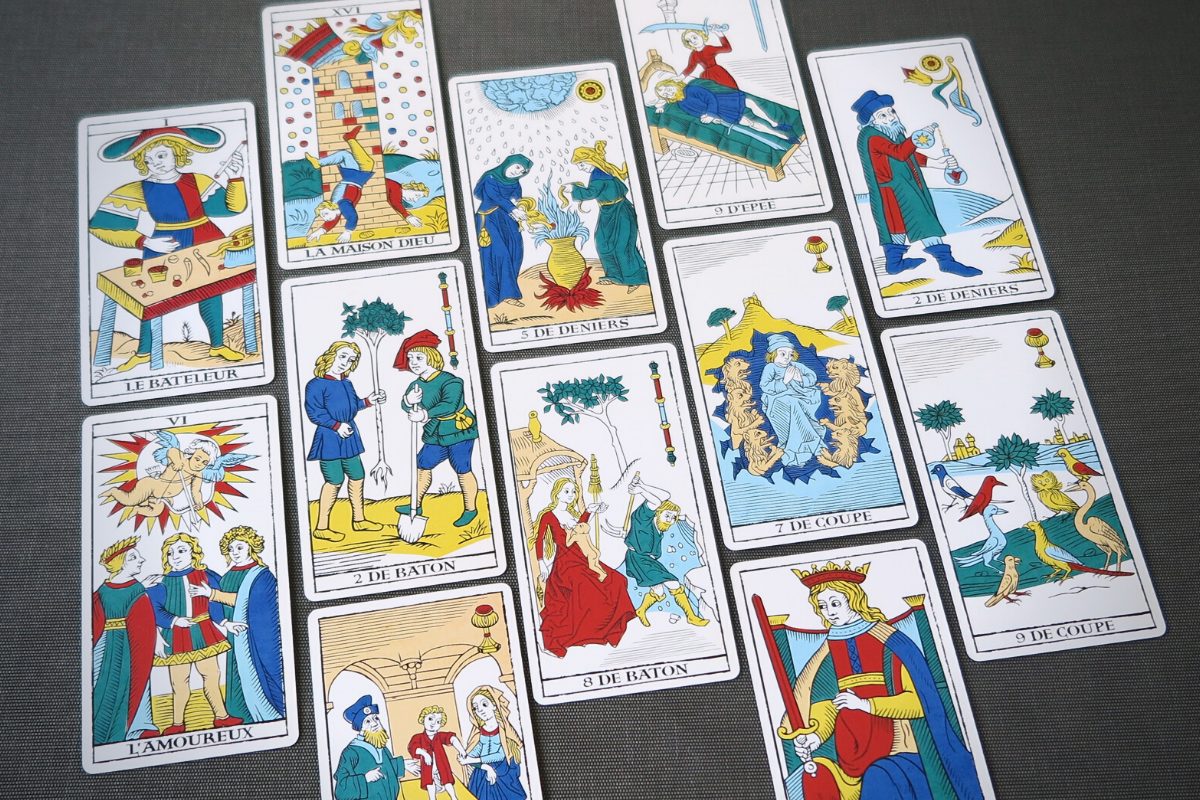
The Tarot de Marseille of the New Incarnation is a Marseille deck with an illustrated Minor Arcana. Unlike Iger and Laverty’s Le Tarot de Marseille-Wait featured above and even Muramatsu’s tarot, Eugene Vinitski and Elsa Khapatnyukovski turned to medieval art, parables, and fables instead of the RWS. The result is a Marseille deck that feels like it was always fully illustrated and made for divination.
The deck includes a nice LWB with information about the creator’s colour choices, descriptions of each card, meanings, and some spreads. I wish it had more details on the illustrations themselves. Some of them seem very familiar.
Tarot de Marseille of the New Incarnation was a Kickstarter project available on Vinitski’s website and Etsy store.
African Goddess Rising Oracle by Abiola Abrams
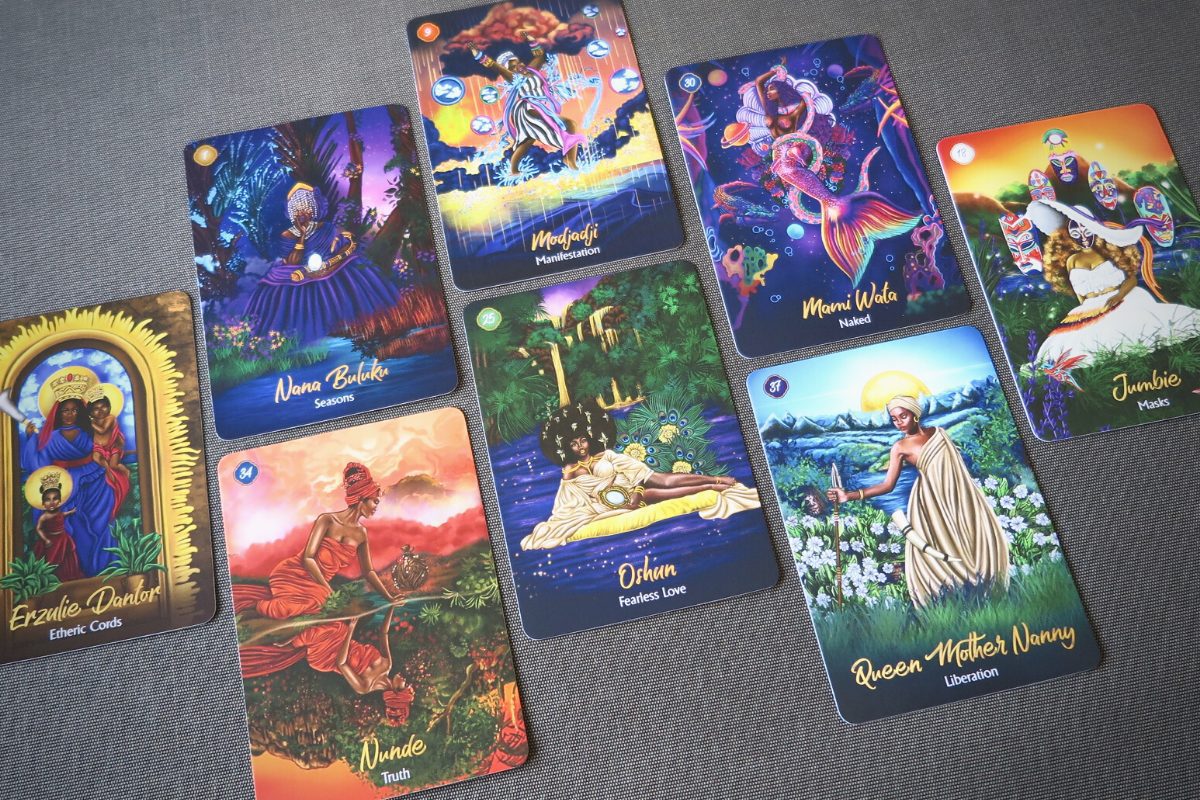
Up until this year, I could count the number of my oracle decks on the one hand. I wasn’t into oracles that much, but this year I was drawn to a few. I haven’t used an oracle in a reading for clients, but that could change in 2022.
The African Goddess Rising Oracle by Abiola Abrams is a rich and glossy 44-card oracle deck. Despite its title, the oracle features more than goddesses. The deck is divided into nine suits, or “Temples”: Threshold Guardians, Ancestors, Conjurers, Warriors, Shadows, Lovers, Griots, Queens, and High Priestesses. It includes a LWB that includes a method to bless your cards, spreads, and the card meanings.
There is an underlying Pan-Africanism in this deck. Whether from Africa or the diaspora, all the figures are depicted as Black or generically African. Goddesses like the Punic Tanit, the Greek Medusa, and some ancient Egyptian goddesses are included here though they are historically and culturally different from goddesses from, say, the orishas of Yorubaland. We see this kind of we see this kind of homogenisation in decks about European deities too, and it might be a hiccup for some readers.
I like that this oracle is specifically Black and is full of figures that I don’t know. I intend to use this oracle to expand my knowledge of African goddesses and work with female orishas.
The Goddess Oracle Deck & Book Set by Amy Sophia Marashinsky and Hrana Janto
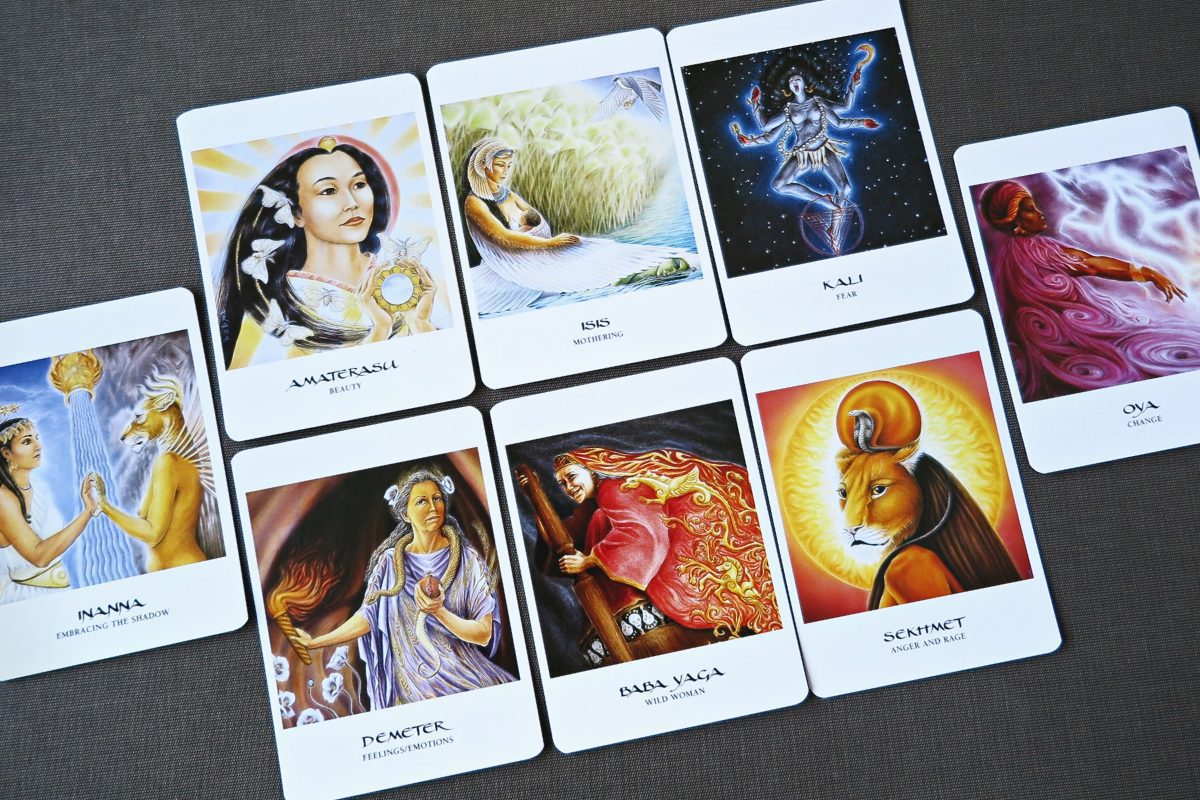
Goddess Oracle Deck & Book Set by Amy Sophia Marashinsky and Hrana Janto is another deck I gave away or sold when I moved from the United States to Australia. I’m happy to have it back in my collection because this oracle has some of my favourite goddess art. I will sometimes place a card on one of my goddess shrines.
The not-so-little LWB contains ideas for using the deck, spreads, and card meanings that include rituals. Initially published in 1997, the Goddess Oracle Deck is still widely available.
Goddesses Knowledge Cards by Susan Seddon Boulet
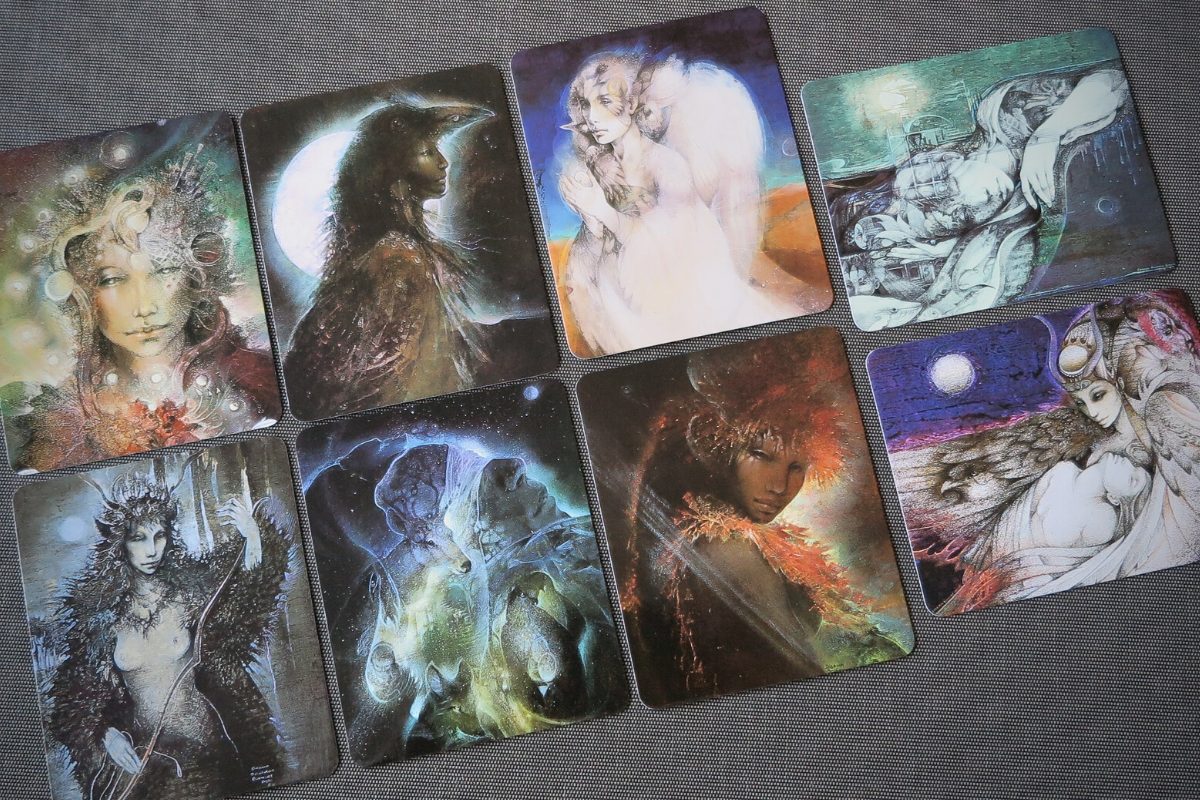
The Goddesses Knowledge Cards by Susan Seddon Boulet are not an oracle but a 48-card deck designed to help us learn more about female deities. The back of the pack explains:
“In learning about goddesses from different cultures, we can recognise these archetypes as parts of ourselves, allowing us a clearer vision of our strengths and weaknesses, and giving us a common thread, a link to the collective unconscious.”
The glossy cards are a little smaller and more square than other oracle decks listed here. Most cards depict the goddess in portrait mode; a few are in landscape mode. There’s no LWB; every card has a goddess on one side and information on the other.
I love this deck because Seddon Boulet’s art is beautiful, layered, and dreamlike. They have an earthy, shamanic feel to them that speaks to the ancientness of these goddesses. I add these cards to my goddess shrines and use them to meditate.
Goddesses of the New Light by Pamela Matthews
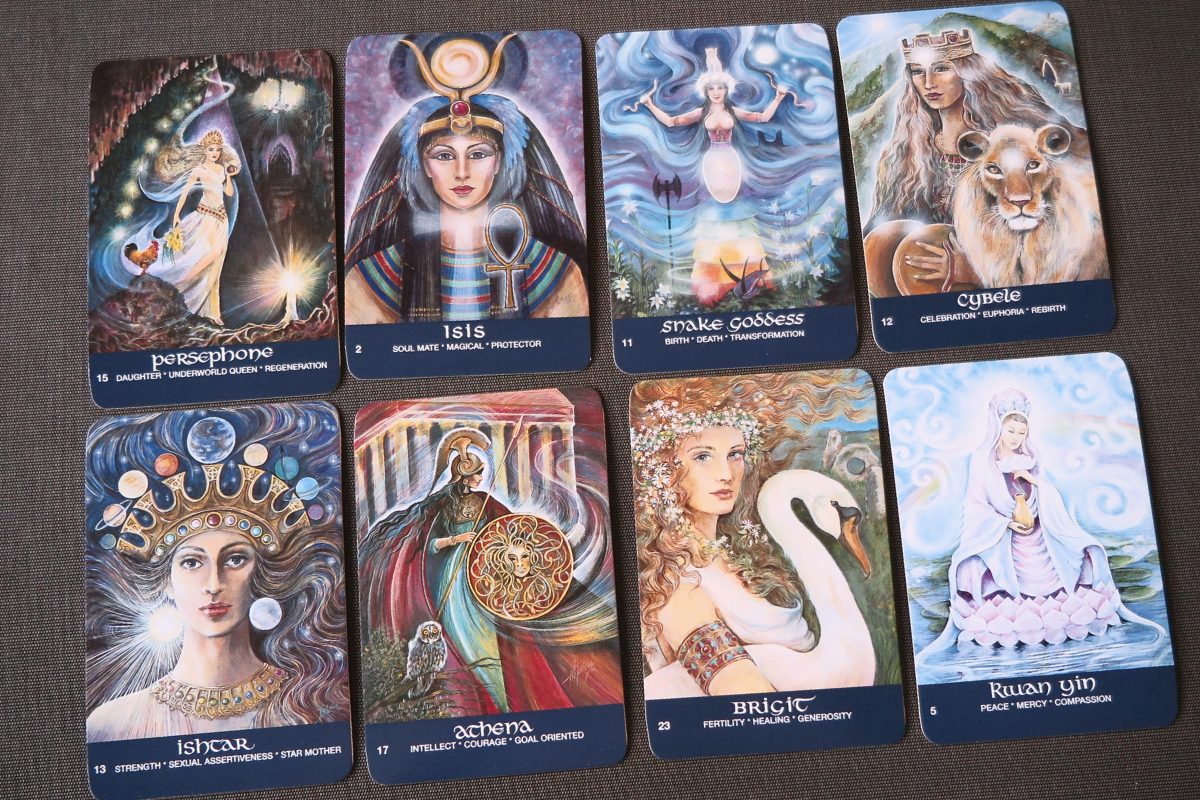
Goddesses of the New Light by Pamela Matthews is the third goddess deck on this list that I re-added to my collection. I have never used it for divination; I love the art and sometimes add the cards to my goddess shrines.
I wanted a deck like the one I had many years ago and found one on eBay. My old version has 27 cards, came in a plastic container that resembles a VHS case, and included a purple wrap and a wooden stand. The cardstock doesn’t feel as high-quality as the other decks in this list. It’s like cardboard, not flexible, and has a different coating on each side, creating a tension that causes a curvature. It’s an old deck, and the art is beautiful, so I can overlook that, especially since I don’t shuffle and read with them.
There is a newer version of Goddesses of the New Light available. The deck has 36 cards and an expanded colour booklet with spreads, meanings, messages, and affirmations. It’s available on Pamela Matthews’ website.
Isis Oracle by Alana Fairchild
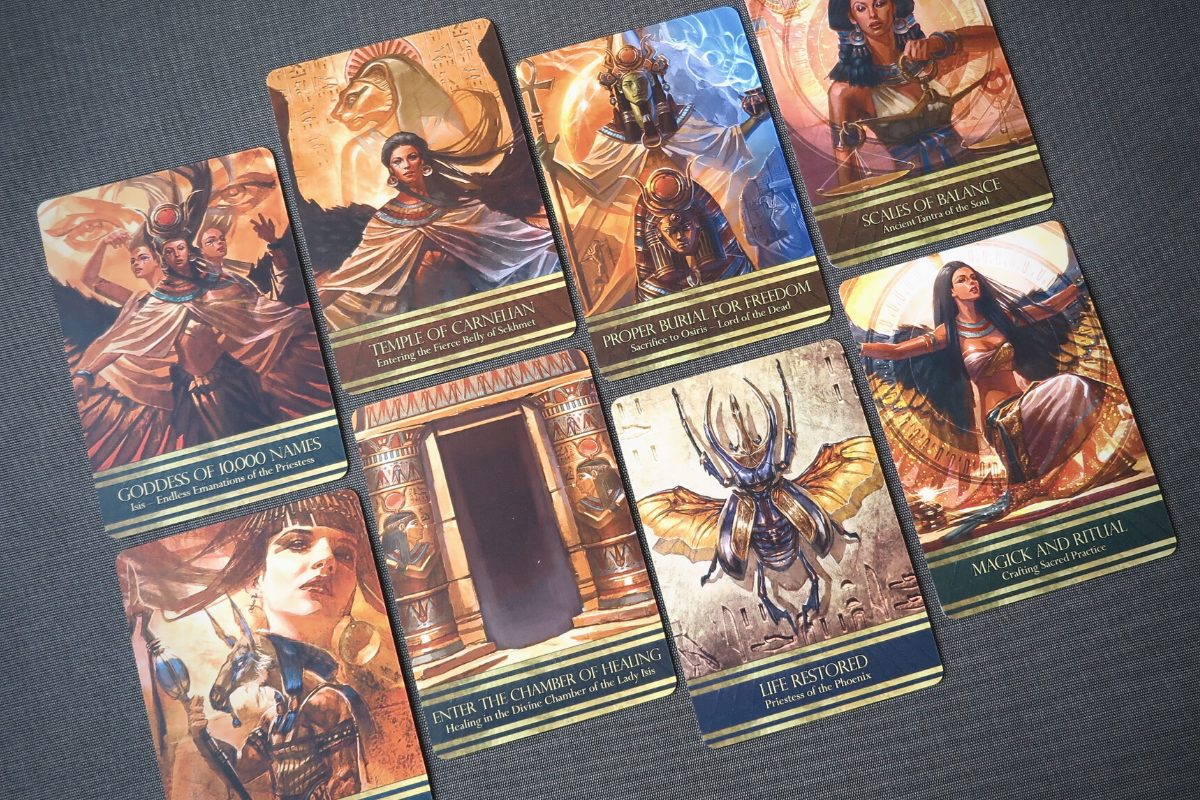
I’d never had a relationship with Isis until this year. It developed slowly, but she showed up for me in mid-September. I purchased this oracle and dedicated it to her. It quickly became one of my favourite oracle decks.
The Isis Oracle has 44 cards featuring dynamic artwork by Jimmy Manton. The guidebook is 220 pages and contains an introduction, spreads, and card messages, which include rituals, guided meditations, incantations, and prayers. This content adds a lot of value to the oracle and is in no small part why I love this oracle so much.
Kali Oracle by Alana Fairchild

The Kali Oracle is the second of three oracles by Alana Fairchild on this list. I’ve been devoted to Kali for many years, and it felt like a duty to purchase this oracle. Like the Isis Oracle, the Kali is a beautiful deck with artwork by Jimmy Manton and a 223-page guidebook with an introduction, blessing, spreads, and 2-4 pages dedicated to each card.
I like the Kali Oracle a lot, but the artwork misses the mark a little. Every representation of Kali in this oracle, except four, depicts the goddess as young, slim, and beautiful, often with a trim waist and large breasts, underdressed and over-sexualised, and conforming to European beauty standards. Kali is commonly depicted nude, but not like this, not like a comic book superhero. I would have liked to have seen Indian art forms reflected in this oracle.
ROAR Oracle by MJ Cullinane
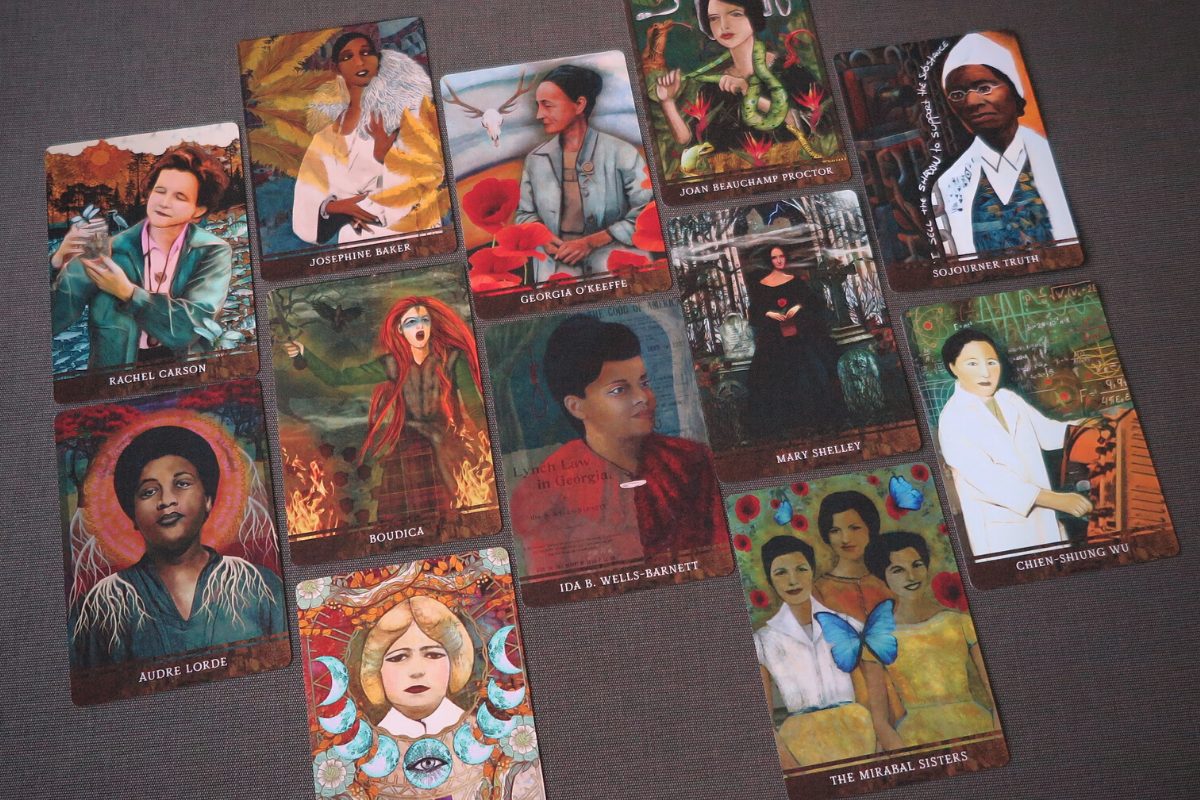
The ROAR Oracle by MJ Cullinane was an impulse purchase, but I do not regret it. This diverse oracle features 54 beautiful illustrations of “radiant, outspoken, audacious, rebellious women”. The cards are thin, glossy, flexible, easy to shuffle, and pleasant to handle. The LWB offers a short biography of the woman on each card. I haven’t used this oracle yet. Like the Art Oracles, I’ll turn to ROAR when I need a little inspiration.
I don’t know if the ROAR Oracle is available in stores. I bought it on MJ Cullinane’s website.
Sacred Hags Oracle: Visionary Guidance for Dreamers, Witches, and Wild Hearts by Danielle Dulsky
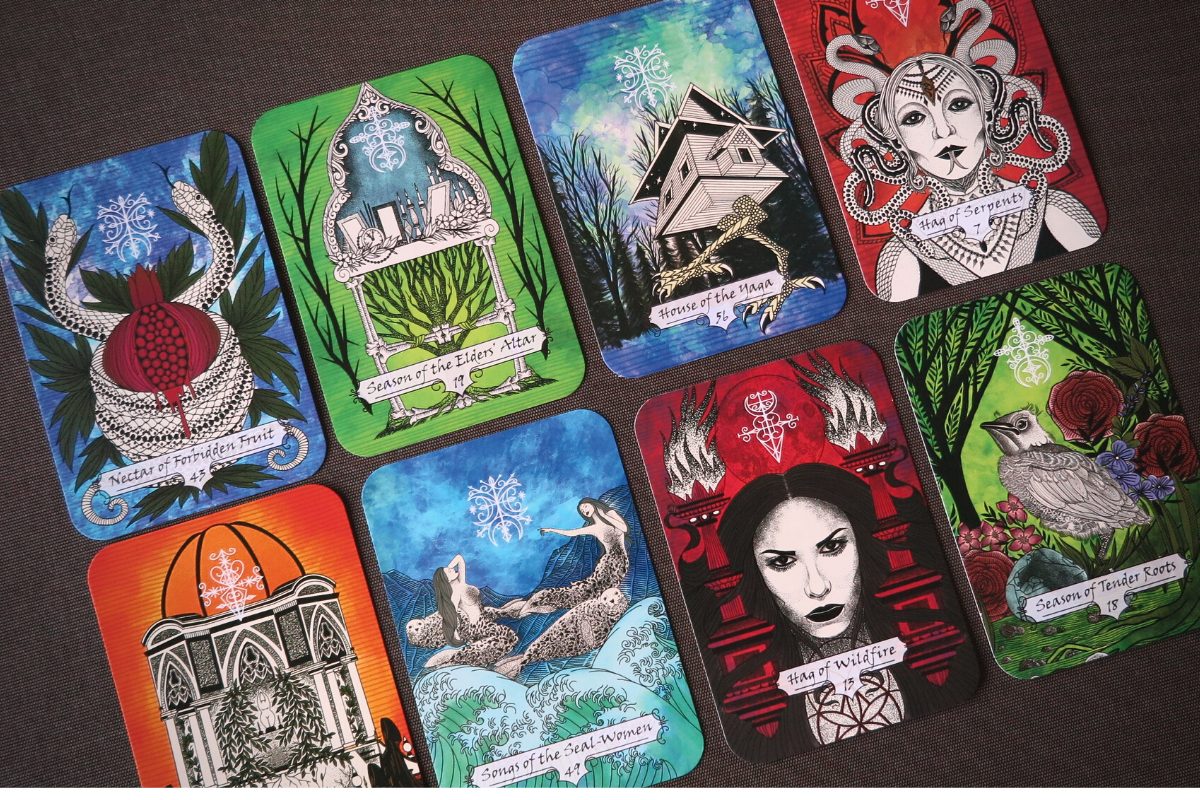
The Sacred Hags Oracle by Danielle Dulsky was another impulse purchase. I was unfamiliar with Dulsky and the illustrator, Janine Houseman, and the artwork is not my style. Still, I liked the name of the oracle, and some friends were talking about it. I felt encouraged to buy it, and I’m still intrigued by it.
I don’t have anything like it in my (small but growing) collection of oracles. The 56-card deck has four colour-coded suits, or sigils, of 14 cards each. The Sacred Hags represent “elderly guidance and grandmotherly wisdom”; the Seasons represent both the lunar cycle and periods in our lives; the Stories represent our memories and myths, challenges, lessons learned, and so forth; and the Spells are “medicine cards” that show you where you are and what magick you may need.
The 153-page guidebook contains information on befriending the oracle, rituals, spreads, and card meanings. I like Dulsky’s voice. She is poetic, encouraging, and passionate about this body of work.
I haven’t used this deck yet, and I can see various ways to work with it. It feels like a deck for deep personal work and not one that I would use in readings for clients.
Sacred Rebels Oracle by Alana Fairchild
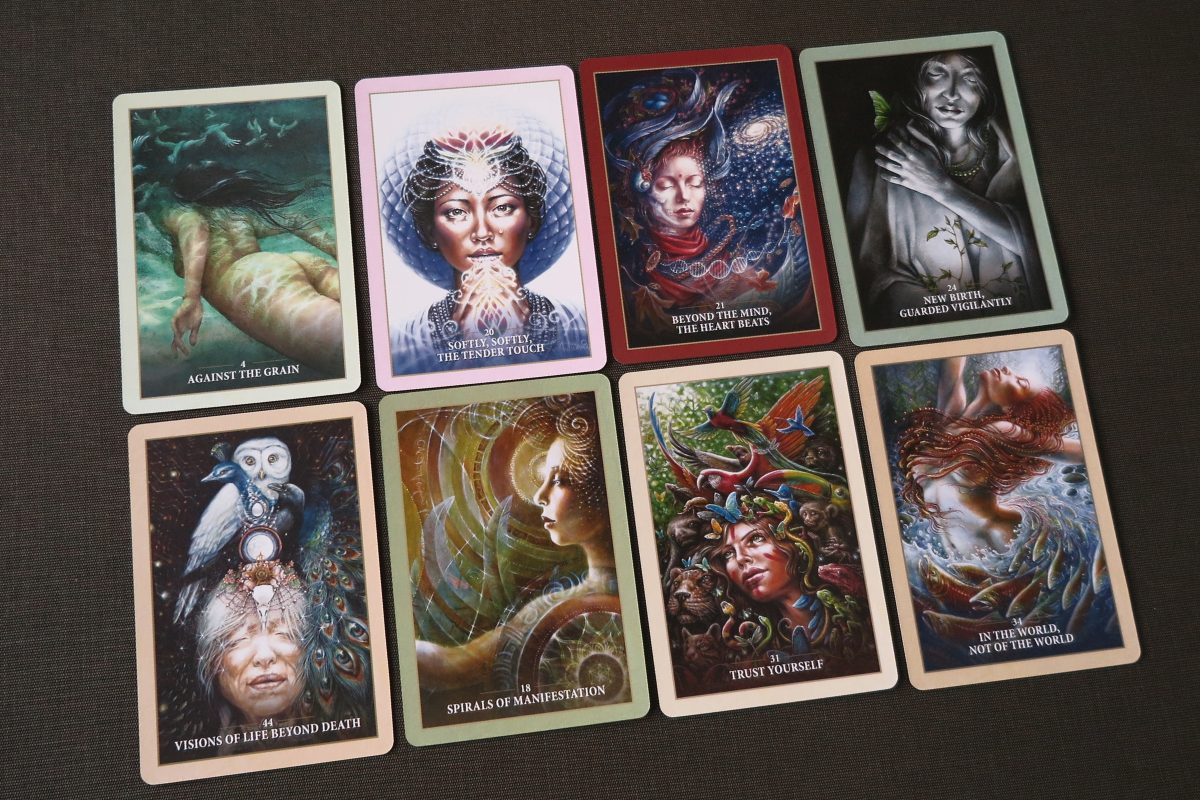
Sacred Rebels is the third and final oracle by Alana Fairchild on this list. It’s very different from the other two. This oracle is about eschewing tradition and orthodoxy and having the courage to live creatively and authentically. It doesn’t exactly scream “rebellion”, though. The beautiful illustrations by Autumn Skye Morrison are soft, soothing, and more diverse than Manton’s work in the Isis Oracle and Kali Oracle.
The 184-page guidebook contains an introduction, ways to work with the oracle, card layouts, and a few pages dedicated to each card which include the meanings and the “healing process”, which are “exercises to “integrate the wisdom of the card and its guidance”.
The Sacred Rebels Oracle has a nurturing vibe to it and lends itself well to self-care work. I could see using this oracle alongside the tarot in certain kinds of readings.
Witches of Legend: An Oracle Deck by Annabelle Lewis
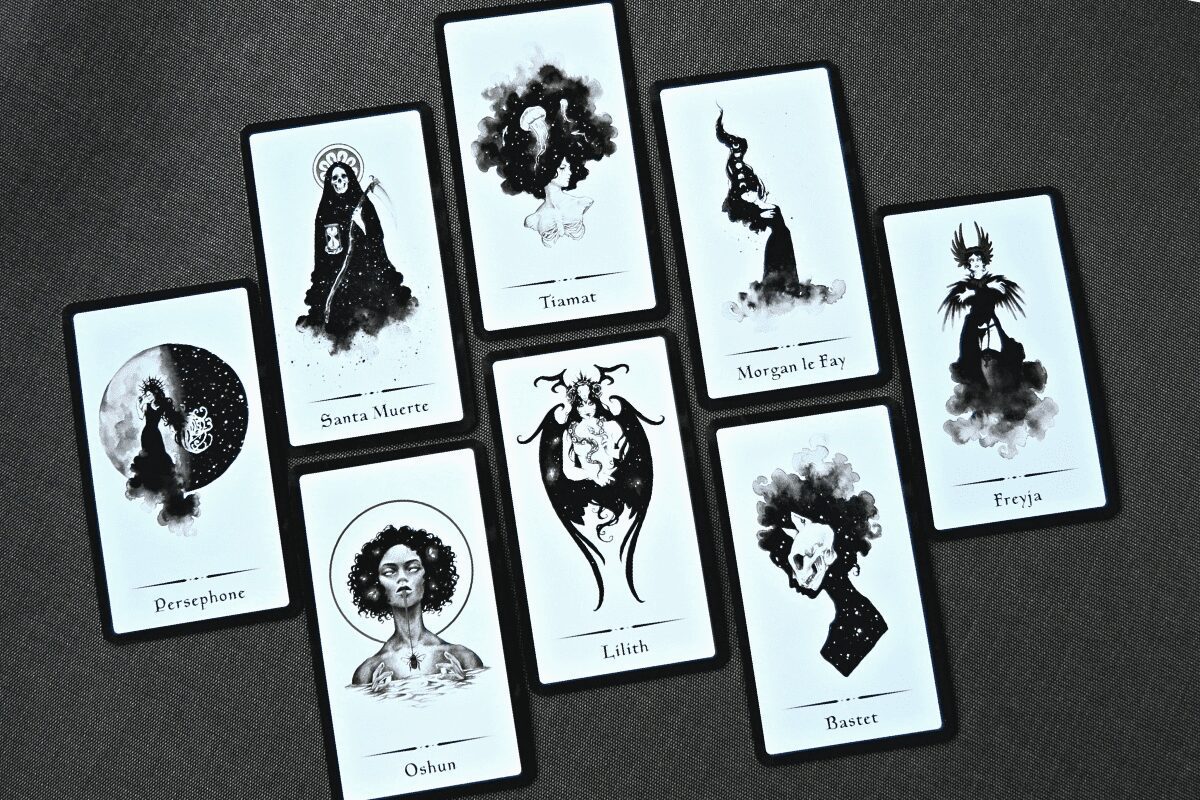
The Witches of Legend is a 34-card oracle of goddesses and witches. Each card is a reproduction of ink and watercolour painting in black and white with gold accents.
I love Lewis’ art and artistic choices. Her depiction of Bastet is unusual and exciting, and her Oshun is one of my favourite representations of the orisha. I also like that her oracle includes figures you don’t often see in decks such as Akilandeswari, Circe, Medea, and Tiamat. The oracle comes with a glossy LWB with an introduction, three spreads, and a page or two dedicated to each card.
My complaint, if you can call it that, is that there are only 34 cards and that the cards are smallish, making the illustrations even smaller. In other words, I want more. I hope that Lewis will make a second set of cards that we can add to these. I don’t expect to read with these, but I like displaying the cards on my shrines like other goddess decks.
Witches of Legend was a Kickstarter project that included two 5×7″ prints (I chose Hekate and Oshun), some stickers, an altar cloth, a drawstring pouch, and a hard enamel pin. You can purchase the oracle and prints on Lewis’ website.
There are still four weeks left in the year, but I think that’s it for my tarot and oracle decks in 2021. I look forward to reading with these next year and to new releases.

